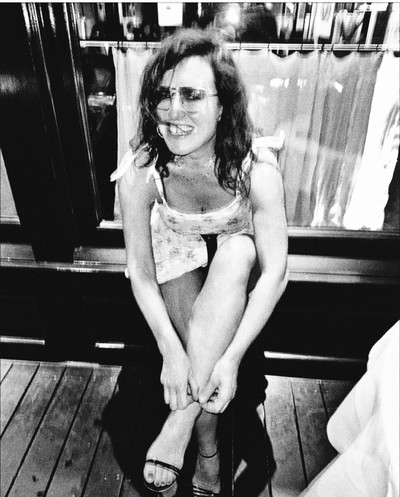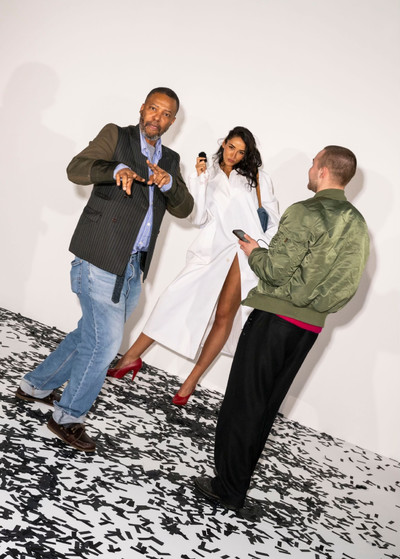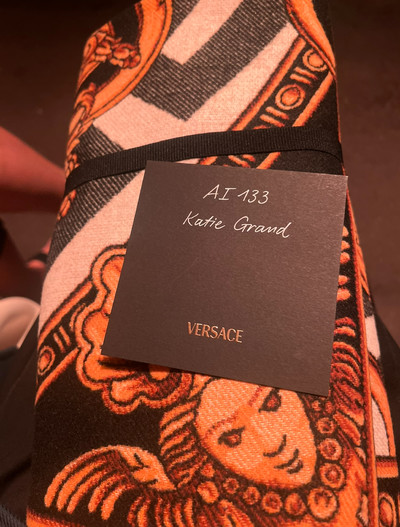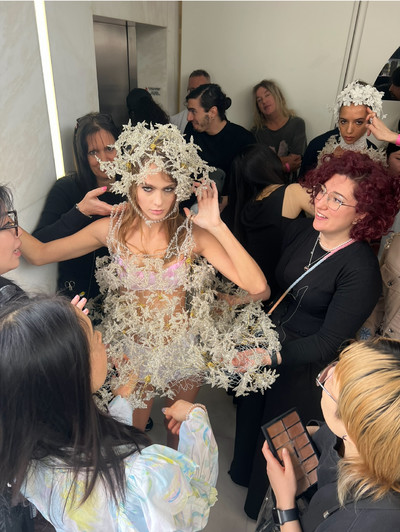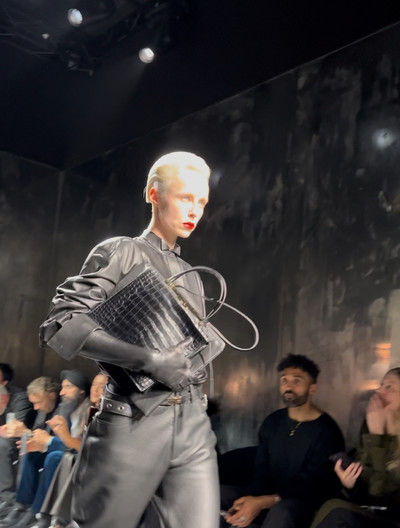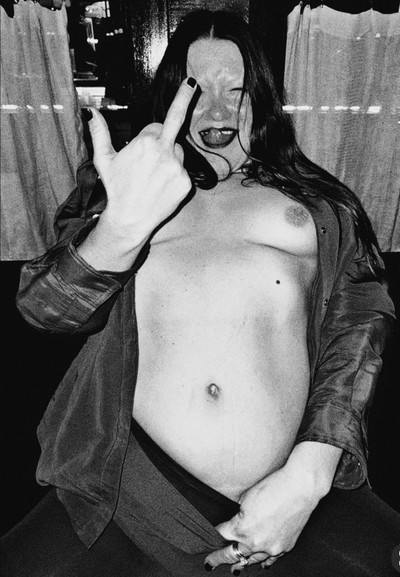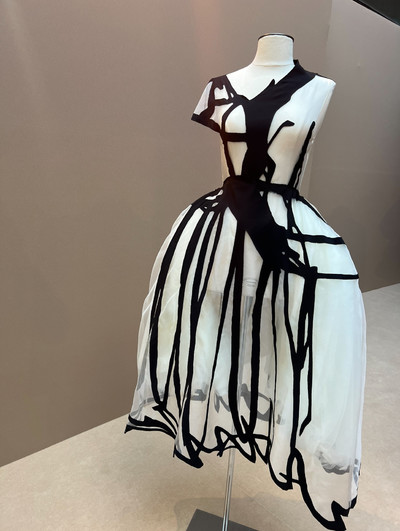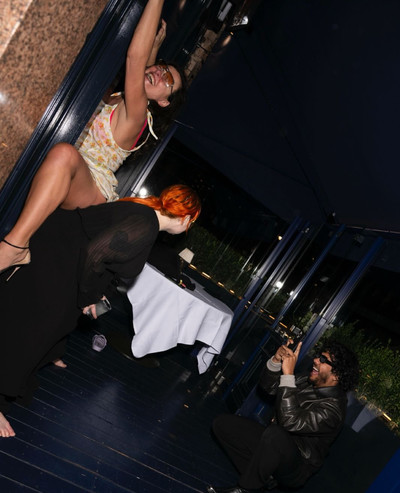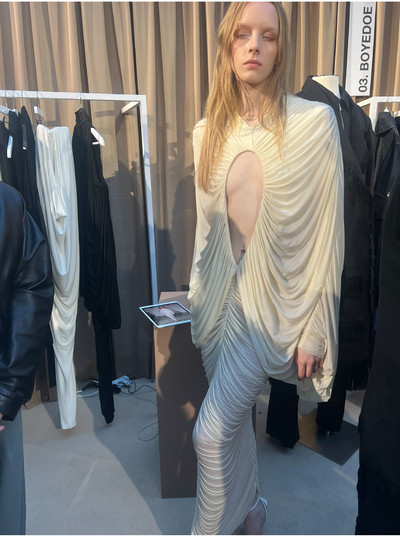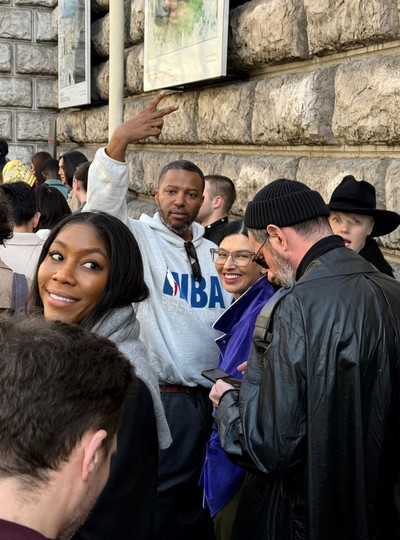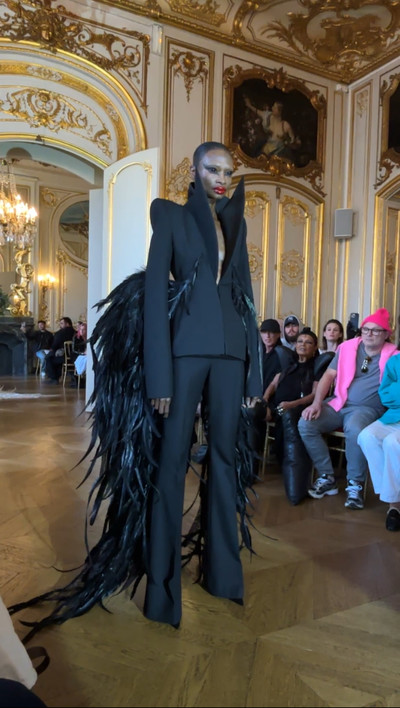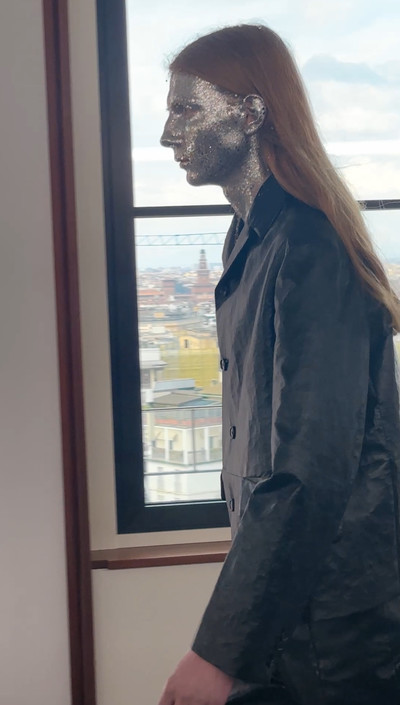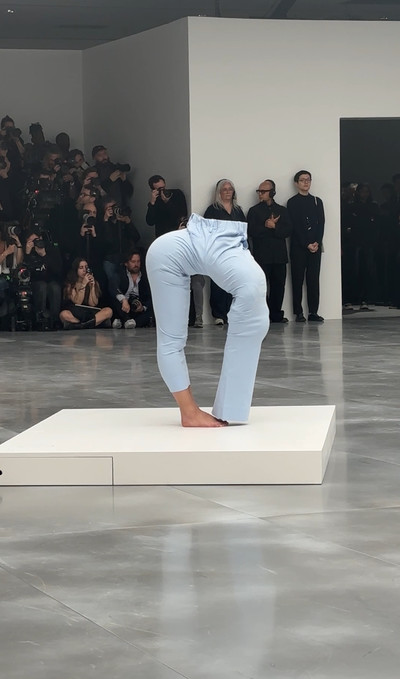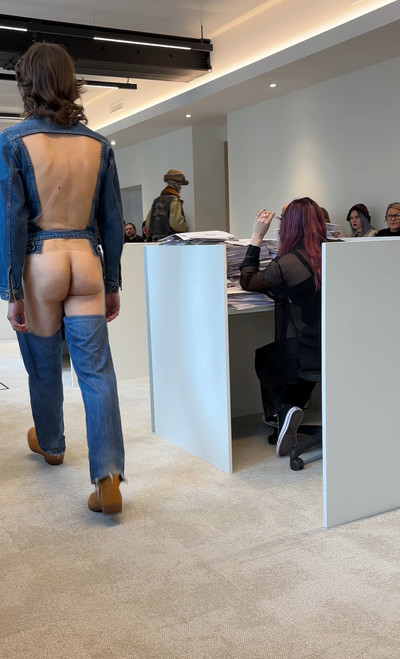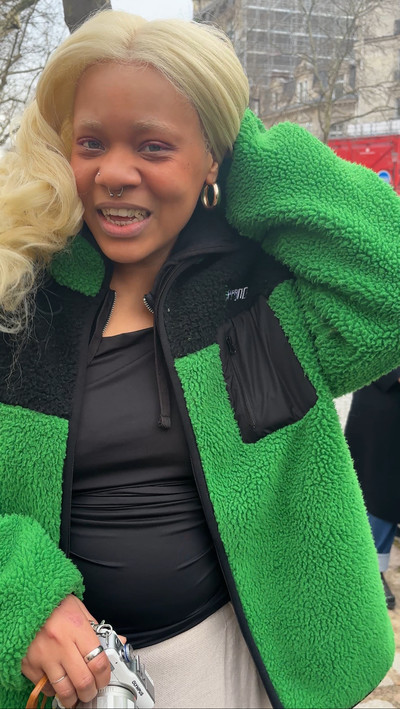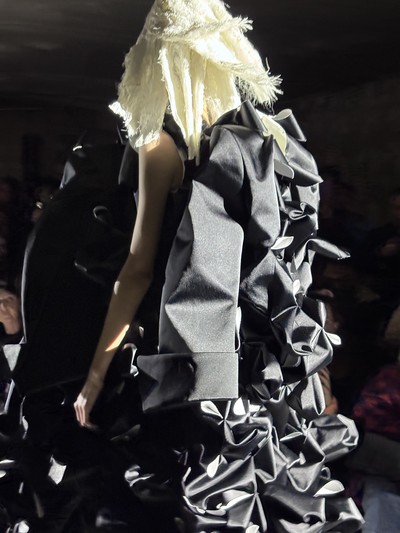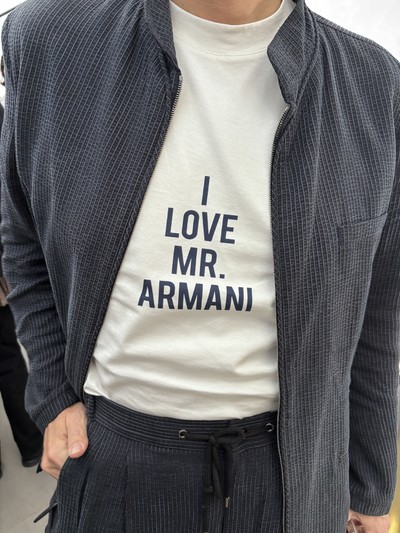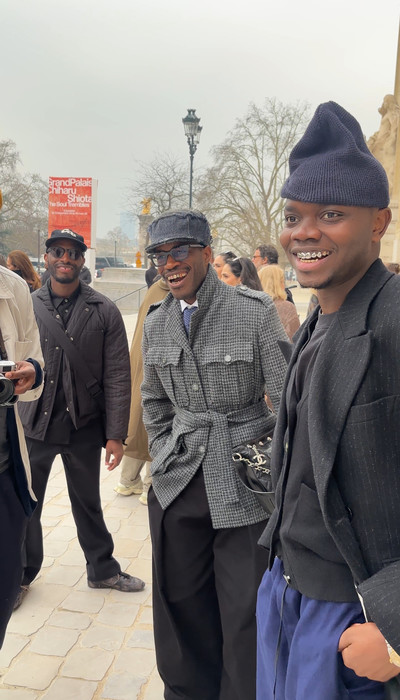‘There was very much this feeling of ‘Are we documenting fashion here, or are we chasing celebrity?’ Then by the time the season got to Paris, it was more about, ‘Are we chasing gimmick?’ I don’t mean gimmick in a patronizing way either; I’ve been behind the scenes at enough shows to know that you can’t just do nothing.’
Since launching Perfect in 2020, Katie Grand has channelled her signature blend of spunky personality, va-va-voom styling, and unfiltered energy into the title’s ultra-glossy print magazine, raucous, celeb-fest parties, brand partnerships, a sassy and creative community… everything. Here, she goes head to head with Perfect’s Milan fashion director, Edward Buchanan – the respected designer who runs his own label Sansovino 6 and who was Bottega Veneta’s first creative director in the late 1990s – to unpack the season.
Edward Buchanan: Alright, recording in progress!
Katie Grand: Recording!
Edward: OK, how are we framing the season? The first city to start with is New York. And I think the first designer to start with is Marc Jacobs, because he starts before everyone.
Katie: When we were hanging out with all the digital guys – not just the Perfect digital team – there was very much this feeling of ‘Are we documenting fashion here, or are we chasing celebrity?’ I think by the time the season got to Paris, it was much more about, ‘Are we chasing gimmick?’ I don’t mean gimmick in a patronizing way either; I’ve been behind the scenes at enough shows to know that you can’t just do nothing. I think that brings us nicely back to Marc Jacobs, because although it was super fashion, and it did have ‘tricks’, it didn’t really have celebrity – it wasn’t a major front-row minute.
Edward: Marc Jacobs is like the designer’s designer. Any designer, including myself, has always admired and watched Marc Jacobs for his kind of fuck-it-all attitude. He does what he wants to do. But what I thought was really intriguing about that show is that his tricks were his opinions. He based his design on what’s going on around him, as a New Yorker. He spoke about freedom, American politics, about craft. It’s funny, I’ve always considered Marc Jacobs the quintessential ‘new designer’, even though he’s been around for ages. He’s the one you go to for new ideas.
Katie: Not that Diane [Kendal] didn’t do a spectacular job, but it was lovely to see Pat [McGrath]’s make-up with Marc again. I think they just push each other’s buttons. That dummy, kind of glitter mouth, beauty spot thing was just so simple. It was one of my favourite beauty looks of the season.
Edward: That little lip. I think Alex Consani had that as well.
Katie: Well, let’s talk about Alex Consani.
Edward: You know, Alex Consani can talk about anything, it’s crazy. Normally when you’re talking to a model they have to prepare a response, but Alex is ready no matter what you ask her. Besides the fact that she’s a beautiful model, she’s just so clever. Also being an openly trans model who’s always protective of the space and talking about the community. Again, politically speaking, it’s not a great time for trans folks across the globe.
Katie: I think she can almost morph into a show, like she did at Hermès. I thought at Schiaparelli, it wasn’t like, ‘Here’s Alex!’ like when she walked Versace and you felt the audience lift up their phones. She’s very professional in how she presents herself on the runway. Closing Moschino was a great moment.
Edward: She was ready. That’s what she always says: ‘I’m ready.’ From designer to designer, she blends into the casting. Depending on what the ask is, she gives it. So if she’s asked to be subtle and chic, she’s giving subtle and chic. If she’s asked to be loud and exaggerated, then she gives that. Let’s talk about Calvin Klein because obviously in New York, it was one of the big returns.
Katie: Can we just say: Veronica Leoni was a female designer having a debut, which was one of only two debuts this season. Actually there was a third debut: Francesca Nicoletti, the new design director at Miu Miu, who definitely needs mentioning because she’s such a wonderful designer.
Edward: Why do you think this is such an issue?
Katie: The women are in the studios. You know, Jane Whitfield at Vuitton, she’s been there since the very beginning. Now over 20 years. There are so many important figures in the studios, but they never make it to number one. I don’t think it’s an easy ride from being the number one inside the studio to being the name above the door, but I wish that those who own these billion-dollar brands would take a leap of faith with some of these female creatives. You’re not getting to a ten-billion-dollar brand without taking a bet on someone to take it from one-to-two billion.
Edward: Working in a woman’s studio and designing clothing for women, it’s so important for me to have the perspective of a woman. You see so often designers designing for an idea that they think this woman should be as opposed to really understanding what a woman wants. Yes, this can be subjective, but I find that in general, women’s perspectives on design – and especially for women’s clothing – is really missing.
Katie: You know who I really enjoyed as a bit of a surprise on Super Tuesday? Véronique Leroy. It was a really beautiful show and reminded me a little of the Calvin show.
Edward: I loved it. I think the last time Véronique showed was five or six years ago. It was a nice reintroduction to her ethos: her cuts were still there, the sex appeal was still there. I thought it was really covetable.
Katie: I thought it was gorgeous. Not that it was anything like Calvin, but something in its ease was very similar.
Edward: I thought Coach was cool. It’s an institutional New York brand at this point, with a big reach. But it felt like a cool New Yorker, and Stuart [Vevers] is now basically a New Yorker.
Katie: I thought what Coach nailed this season were the pieces themselves. It was very Balenciaga-esque in its format, with a lot of very wearable clothing, that you kind of shopped while you looked at that show. It was great.
Edward: I wanted to talk about Luar and Willy Chavarria. Willy showed in Paris, but it’s very interesting to see that kind of Latino energy in New York. Willy has been very consistent about that energy, and speaking about where this actually comes from. What Luar said is that this collection is about the Gallianos, the Gaultiers, the Lacroixs. That’s what I love about him. You go to that Luar show, and you know it’s going to be madness. He’s going to have the ballroom children there. It reminds me of going to clubs in New York in the 1990s. There aren’t so many designers in New York that are consistent about that kind of energy. It’s a very London thing, actually. I’m sure you had a lot of those shows in that period.
Katie: We did. They were always two hours late and you waited. That Hussein [Chalayan] show where it was two hours late. It got to the point where we sat there for so long that we wondered, ‘Is this the show? Is this the joke?’
‘So often, you see male designers designing for an idea that they think this woman should be, rather than understanding what a woman actually wants.’
Edward: So let’s talk more about London this season.
Katie: I thought Dilara [Findikoglu] was fabulous. A special shout-out to Whitaker Malem for that final leather look in her show, which was a masterpiece of engineering.
Edward: People really want to associate her with McQueen and its history. I think what she’s doing could be aligned with that world, but she’s doing something which is really of this generation. They really want to talk about handcraft, they really want to talk about understanding the body. It’s not necessarily so referential.
Katie: She’s got the bite of McQueen, hasn’t she? We all loved Duran [Lantink] and, you know, he’s cool and it’s sexy, but – this is generalizing – it’s from a much more conceptual place. Dilara has that London gnarly girl vibe.
Edward: There’s a grit to it.
Katie: It’s great that it’s a woman designing sexy clothes for women.
Edward: It is. I actually want to talk about Duran a bit. Even before the end of Paris, I made a statement that this was the show of the week. I defend that comment. I talked to him beforehand and he gave me the liner notes of what his intention was with this show. It blew up. And it blew up because of the male model wearing the breast top at the end, but a lot of people didn’t see the first look, which was a female-identifying model wearing the chest of a ‘man’. Then there was this beauty that happened in between. What Duran said to me at the beginning is that he was really concerned politically and wanted to lean into what was happening in the world. But he wanted to approach that in a very natural way. There were some beautiful clothes in that collection. Yes, there were tricks and things that went viral. But you know, when you walk out of a show and you’re just like, ‘Wow’. There was this uplifting energy. You saw beautiful design, it was cool, the music… In terms of an independent designer really having the platform to express what he had in his heart, that was a solid show for me.
Katie: There was no fat on that show. There was nothing in there that they could have cut. It was so precise. I wasn’t actually at the show, but that Sunday was the day I thought, ‘Oh, I really wish I’d been there in person.’
Edward: Then you go to a show like Valentino or Balenciaga, with highbrow production. The production of the Valentino show was really impressive. You walk through this bathroom, and enter into this red space, and there’s the smoke, the lighting, the energy, the cutting of the music. Everything was so beautiful in terms of show production.
Katie: I loved the clothes at Valentino. There were so many beautiful things.
Edward: What’s really nice about Alessandro is that Alessandro does Alessandro. I don’t know what everyone is expecting from a creative that really hones and owns an idea or a style. You want them to continue to do that. That’s what you love about them. Having moved to another fashion house, I think his starting points come from a different place, but the interpretation is Alessandro’s. It’s always quite confusing to me when people are expecting to have something that’s really not Alessandro Michele.
Katie: If you think back to that first Gucci men’s show [Autumn/Winter 2015] that he did in eight days, not only did he rip up the catwalk that was already being built, but he ripped out the studio. He needed to work in a very specific space and he wanted that first show to be specific. When you go back and look on Vogue Runway, you’ll see that on some of the jackets, they managed to shorten one sleeve but not the other – it was done so last minute. You don’t show in eight days unless you know who you are.
Edward: Taking a lot of risk, too, because it was very, very different from what anyone might have expected from Gucci at that moment. People were annoyed or even disturbed. But nothing in the history of fashion has come without a degree of risk. You know, Chanel took off the corset, Giorgio Armani took out the construction. Nothing in fashion that we’re ever interested in comes without risk. You know, I want to be annoyed, rather than bored. Anyway, what else happened in Paris?
Katie: Sarah Burton’s Givenchy debut. I wasn’t there, but everyone seemed to have such energy around what she’d shown, I really wish I’d been there.
Edward: Me too.
Katie: Maybe it’s hard for us to get really into that, because I’ve not seen the clothes up close, except for Gwen [Gwendoline Christie]’s outfit, which I saw some detailed photographs of. It looked stunningly well made, the fabric was gorgeous.
Edward: From what I saw online, and the bit of research I did about the collection – because I was also curious about it – I liked that she studied some of the more obvious codes of Hubert de Givenchy, like the backwards jackets. A lot of those ideas come from the archives. Here you have a really talented woman who has a history in design and an idea about design, and she has the opportunity to really express that. I think a lot of people were really excited about this collection, once again, with it being about a woman’s perspective. And so, if nothing else, I’m really happy about that.
‘One Hussein Chalayan show started over two hours late. It got to the point where we were sat there thinking, ‘Is this the show? Is this the joke?’’
Katie: What else happened in London?
Edward: In London…
Katie: We had a party! We rolled around on the floor.
Edward: Exactly. You know, I was only there for two days, but there’s a brand called Maisonartc by Artsi Ifrach, a Morocco-based designer. He didn’t necessarily come from design and he’s working with upcycled objects and artefacts and materials found in Morocco. But the most interesting thing about my conversation with him, which I’ve heard from a lot of independent designers, is he’s talking about working with his hands, much less industrial. I thought that that show was fucking fierce.
Katie: That takes us nicely onto the LVMH Prize, actually, because that was a lot about upcycling. My personal favourite – because of my love of hand knit – was that guy who did Pillings [Ryota Murakami]. There was this gorgeous ecru, very heavy cashmere cable knit cardigan – my favourite thing of the season – that had these wooden hand painted angels on it. I just found it so charming; I was really blown away. Then there was Boyedoe from Ghana, who’d done all the slash denim pieces that he’d stitched together.
Edward: What about the guy who does the suits, Soshiotsuki.
Katie: Just phenomenal.
Edward: The construction on the inside of those jackets was sort of crazy.
Katie: I spoke to him for a long time that day. He was saying that when you go to vintage stores in Japan, quite often you will see a fancy Western jacket that has been shortened. So that’s what he was inspired by, the re-proportioning of vintage suiting through the years. It just looked so cool and easy.
Edward: It’s so very meticulous, nothing looked like it shouldn’t be there. You look at it and it just seems very basic, but it was quite twisted.
Katie: And such nice colours. But while we’re here, I was just thinking about Sinéad O’Dwyer – I really enjoyed seeing her as part of the LVMH Prize. She’s another female designer, and in a season where many of the diversity conversations from recent years seem to have fallen by the wayside, I think it’s important to give a shout-out to Sinéad, as well as to Fendi, Susan Fang, Marni and Ludovic [de Saint Sernin]. I think the people that continued to show [diverse] bodies on the runway, well done to them. We had an interesting casting when we were doing Susan Fang in Milan. There just weren’t any curve girls there, so we ended up street casting. I think there just wasn’t the work for a lot of plus-size girls in Milan this season. The agencies just didn’t have them there, or certainly not by the end of the week. That was very disappointing.
Edward: A few seasons ago, all those conversations that came up during Covid – about size, colour, gender – were actually on the table. Maybe in a time when global politics is shifting, that even seeps down into the work we do in creative spaces… Which makes me just think, ‘Fuck, here we are again.’ But bravo to those brands.
Katie: I really enjoyed talking to Sinéad about her process. She really reminded me of Karoline Vitto in many ways, just looking at designing for bodies. Neither of them are like any of the designers that I’ve worked with in the studio.
Edward: Sinéad is major also because she had to build her forms based on those bodies. Most of the brands don’t even cut up to those numbers. Same with Karoline. Oftentimes they have a hard time getting purchased by stores, because they don’t think that they have valid consumers who are purchasing based on the cuts that they’re doing. There was also Torishéju who is UK-based.
Katie: She’s Nigerian-Brazilian, she shows in Paris once a year.
Edward: I saw the show last season and I liked her perspective. I hadn’t seen all of the complex cutting in her clothes when I saw it on the runway, it somehow seemed very minimal. But I liked the complexity when I dove in. It was good to see at the LVMH exhibition.
Katie: And also Tolu Coker, who I think has a really interesting work process. It’s not easy to show in that NewGen space in London. It’s a great space, but it’s very difficult to make it feel warm, like it’s yours. Tolu’s done a really good job of that.
Edward: Again, we’re talking about young, independent designers really wanting you to understand what the craft is. She created a kind of a studio in the interior where she had her machines, and she had her craftspeople in there working. She showed you her pattern work. She showed you her design process and then on the outside of that space was the actual presentation, where she had music and you could see the clothing on mannequins or models. She’s so intelligent. I really loved talking to her. I think she’s one of the cleverest and well-versed creatives that I’ve talked to in a while.
Katie: I also liked the reality check this season, like Feben. She had someone help her out with some sponsorship for a dinner and people wore the clothes. It was nice to see the clothes being worn at an occasion. It’s very London, isn’t it? That thing of, ‘Oh, well, I don’t have the tens or hundreds of thousands of pounds to put on a show, but I’m going to turn up with something.’ I think the London kids today are good at that. You know, this never happened in the 1990s, everyone just went bankrupt instead.
Edward: I’m still quite new to the editorial space and going to shows, but I always expected that level of creativity from London. At the end of the day though, in terms of institutional brands, there are not many that show in London. I don’t think enough people pay attention to those smaller brands because a lot of people don’t go to London, or they don’t stay through to see Burberry, which ended the week.
Katie: I went back and looked at the Simone Rocha show this morning and I think she really led the way for some other shows this season. The kind of extensive use of fake fur, this belief in the ruggedness in the pieces, the toughness in the styling.
Edward: A lot of cool casting as well.
Katie: That was a great London show.
Edward: I felt the same way. The space was so beautiful. It was a very well-articulated show. And again, we have a woman’s voice, a woman designer, understanding exactly who the consumer is that she’s designing for.
‘Alessandro did his first Gucci show in eight days. On some of the jackets, they’d managed to shorten one sleeve but not the other – it was so last minute.’
Katie: So going to Milan. Francesco Murano, who is also nominated for the LVMH Prize, is probably also worth mentioning. And Giuseppe di Morabito, who showed in Milan for the first time.
Edward: The one with the robots.
Katie: Exactly. Francesco’s only 27 and I just love what he does. There’s a sass to it. He’s dressing his friends. It’s very sexy but really beautifully done.
Edward: He is a dressmaker. That show was held at the Fondazione Sozzani, so it was kind of small and intimate. He had a lot of control for such a young designer, because it was quite minimal. The only thing you saw were these silver balls that the models were holding.
Katie: I thought that was really clever.
Edward: It was really, really nice. They walked very slowly and looked like these really elegant statues. The maturity of that show was beyond his years as a designer.
Katie: I think he’s the next Ludovic kind of designer. He’s out, he’s dressing his friends…
Edward: Giuseppe di Morabito is another thing. The clothes were very maximum design. There was a lot of ruching and metalwork and fake fur, but done in an Italian way. And like Luar or even Willy in New York, these designers know what the viral moments might be from the show. I think he’s the Italian version of that for me. There were a lot of things happening: you walked into the space, with this robot, and we were like, ‘What’s going to happen here?’ It was very digital. I think young designers who don’t have a lot of marketing budget really have to think about what might potentially be a moment that people are going to talk about after the show. A brand like Coperni, for instance, always thinks about that. I really enjoyed the Avavav show in Milan. These Milanese kids have no money, but they always manage to come up with an idea where you’re like, ‘What the fuck?’ Avavav had models coming out of a grave. The show opened with this hand coming out of the ground, and then it caves and the models are walking out of the grave. That was a good show for a young designer.
Katie: Silvia Fendi should have a shout out. I’m very conscious of the women!
Edward: I walked out of Fendi feeling high. It just reminded me of the old-school fashion show: everything is together, the Barry White music starts pumping, the models look gorgeous, it’s rich, there’s a carpet, there’s mirrors, there’s banquettes. It was sexy. It was the extravagance and beauty that you expect from Fendi.
Katie: And everyone looked stunning. They looked so beautiful.
Edward: For me, that was a major show.
Katie: It was just nice to hear that it was pretty much an all-women team. You felt there was probably champagne before the show started, you know, they were all having a really good time together. You kind of got that at Miu Miu as well with Francesca now as Head of Studio, Miuccia, Lotta. You know, it felt like women dressing women.
‘There weren’t many plus-size girls in Milan this season, so we ended up street casting. There just wasn’t much work for them – it’s very disappointing.’
Edward: Which is correct! What happened at Miu Miu was interesting. Up until now, it has been more sports-oriented with the Carhartt-esque jackets and the hoods. It became very Miuccia again, no? They walked out with that bag, and there was lingerie… it became very Italian sciura which is very Miuccia Prada. It felt pro-woman in its design, and that’s the Miuccia I love.
Katie: Yeah, me too. I don’t know what was going on behind the scenes at Gucci, but it certainly looked like Suzanne Koller wrangled that collection together so beautifully. I thought there were pieces in there that looked very Suzanne. The whole Gucci crew did a really nice job and it was such a beautiful presentation. Then actually segwaying into Chanel, which I thought was also a really great team effort without a designer there. Not taking away from any of the shows at Gucci or Chanel that have had great designers behind them, but both teams did well.
Edward: I always think you get a gauge of the temperature when you walk into a space, and the Gucci space felt sexy, in an almost Tom Ford way.
Katie: That shade of green.
Edward: There was this body with the jacquard logo that went around the middle of it. I think it was one of the last looks out. It was like a send-off; really, truly charged.
Katie: Which takes us nicely to the Tom Ford show. As a presentation, that room was so lovely, and the fact that they were serving martinis and that it was dark and felt louche. It was very decadent. It felt very Tom.
Edward: Did you have a martini?
Katie: I had one and a half! Susannah Frankel had three and was smashed. In its staging, it felt very much like an old Helmut Lang show, even though it was nothing like that, just in the way that the models kept coming out. Edie [Campbell] and Kristen [McMenamy] and all those ice white blondes with the bleached eyebrows and the red lips. They completely nailed the look.
Edward: I wasn’t at the show, but you could feel Tom Ford in terms of the brand alignment. Did you feel Tom Ford in the clothes?
Katie: It had a simplicity that was very Tom. He always used to say, ‘Get the hair and the shoe right, and everything else in between just falls in place.’ When you go back and look at that red leather coat, maybe with snakeskin, or the green satin suit, they’re quite simple pieces, but very nicely done.
Edward: I’ll be interested to see how that goes. It’s interesting how the natural hand of Haider is a bit more romantic than what I remember from Tom’s and it’s interesting how those can bridge. Haider is not Tom Ford, and he shouldn’t be, he’s designing for the Tom Ford brand.
Katie: I really enjoyed the Chloé show, talking of female designers. It was really pretty. And a shout out to Isabel Marant too!
Edward: At Chloé, I liked the fact that she hit all those textbook codes that we think of when we think of the Chloé woman. Without even a tag on it, you just know that it’s Chloé.
Katie: I think a lot of the shows that people seemed to enjoy this season were those that respected the codes of the brand. Gucci, Fendi, Dior.
‘I still consider Marc Jacobs the quintessential ‘new designer’, even though he’s been around for ages. He’s the one you go to for new ideas.’
Edward: OK, so we have some additional questions here. Do runway trends still matter?
Katie: No. I was never that kind of stylist or editor. I mean, I would always say if look 25 is not available, look 24 is fine. I’m not gonna kill myself if my short-skirt story has a long skirt in it! That’s not how my brain works.
Edward: Yeah, I don’t think so either. When you’re moved or inspired by something, then you just kind of go with it. Considering you have been going to shows for so many years, Katie Grand…
Katie: I’m not amazing at going to shows!
Edward: How many do you physically attend? How important is it these days for you to be in the room?
Katie: I think the livestreams these days are so good. However, I think you can only ever really feel stuff if you’re in the room, which contradicts the fact that I don’t go to that many things.
Edward: But you did it for so many years.
Katie: I just got into being behind the scenes. I think you have such a passion and such a tolerance for the relentlessness of it. And, you know, so do Sid [Rounthwaite – Perfect staffer] and Bryan [Yambao – Perfect editor-in-chief]. It’s not that I’m cynical about it, I just get a bit anxious about it all.
Edward: Going to shows now, it becomes increasingly difficult because of what happens out front. All the photographers and all the crowds of people. It’s not just industry.
Katie: The security is unnecessary.
Edward: There were so many this season, and they’re not just holding you out, they’re putting hands on you. And the celebrity element. Chappell Roan and Doechii were at so many shows and they were all dressed specifically for each show. I often wonder: is this celebrity seeding actually a disservice to the brand? Maybe it helps online, but does it really help on the sales floor? I don’t know.
Katie: There was that article recently on the Business of Fashion about the social reach from the Milan shows and I thought it was really interesting that Moschino was number two but didn’t really have that many celebrities. There were a few tricks – the spaghetti bag, or Alex Consani with the bin bag which are very Moschino codes – but I thought it was really interesting that it had a lot of social reach without, you know, Chappell or Madonna.
Edward: I think it had a lot to do with the joy that happened in that show. In the same way I walked out of that Dsquared2 show like, ‘Wow!’ It was so fucking fun. That show just felt so good, it felt so joyous.
‘I think a lot of the shows that people seemed to enjoy this season were those that respected the codes of the brand – Chloé, Gucci, Fendi, Dior…’
Katie: What’s interesting is that Doechii had been offered a bunch of stuff in Milan, but she wanted to appear in the Dsquared2 show. She’s a superfan of the brand and she wanted to perform. I was happy for them in that someone who’s so hot in terms of youth culture right now, was like, ‘Yeah, that’s what I want to do.’ And JT did it, too. They felt like the right hot talent to be in the room that night.
Edward: It doesn’t always work out to be that honest. I sometimes question if the return is strong when working with a celebrity or influencer. Sometimes you go to shows and they’re just people dressed for the sake of dressing. The next question they want to know is, what is Perfect’s approach to covering the fashion month shows, how has this evolved since you launched in 2020?
Katie: We’re obviously very tight, aren’t we? We’re all on a group chat from 7am, and I think we’re all pretty flexible in our approach. You do need a lot of stamina to get through these shows and have joy for it every day. It does start at 7am and finishes at midnight. Sometimes you think you’ve got the formula for the season down, don’t you? You’re like, ‘Oh God, everything’s about celebrity and everything’s about the front row.’ But then you get days like Sunday and it’s just non-stop numbers all day – that’s Duran, Valentino and Balenciaga.
Edward: The beauty in doing this job is building relationships. I’m not saying this just because he’s probably there listening, but I love working with Sid.
Katie: He’s here, he’s not listening.
Edward: He’s a fucking disaster, but I love it! That makes things easier. I guess if you find yourself navigating these spaces with people that you don’t enjoy being around, then it would probably make it that much worse.
Katie: I think it’s just great having someone who’s 22 on the team, because they are seeing it for the first time. There’s no cynicism.
Edward: What do you think is the influence of the fashion critic in 2025 and do you have any favourites?
Katie: Lyas. Lyas. Lyas. Lyas and Lyas.
Edward: And why is that?
Katie: He’s young, he’s not been doing it for that long. He’s the same age as the models, he can go backstage and slots in really well. His post at the end of the Saint Laurent show where he’d got them all as statues – he’d managed to get a room full of fashion people, fashion people that had no energy left, and they performed for him. And I was like, good for you.
